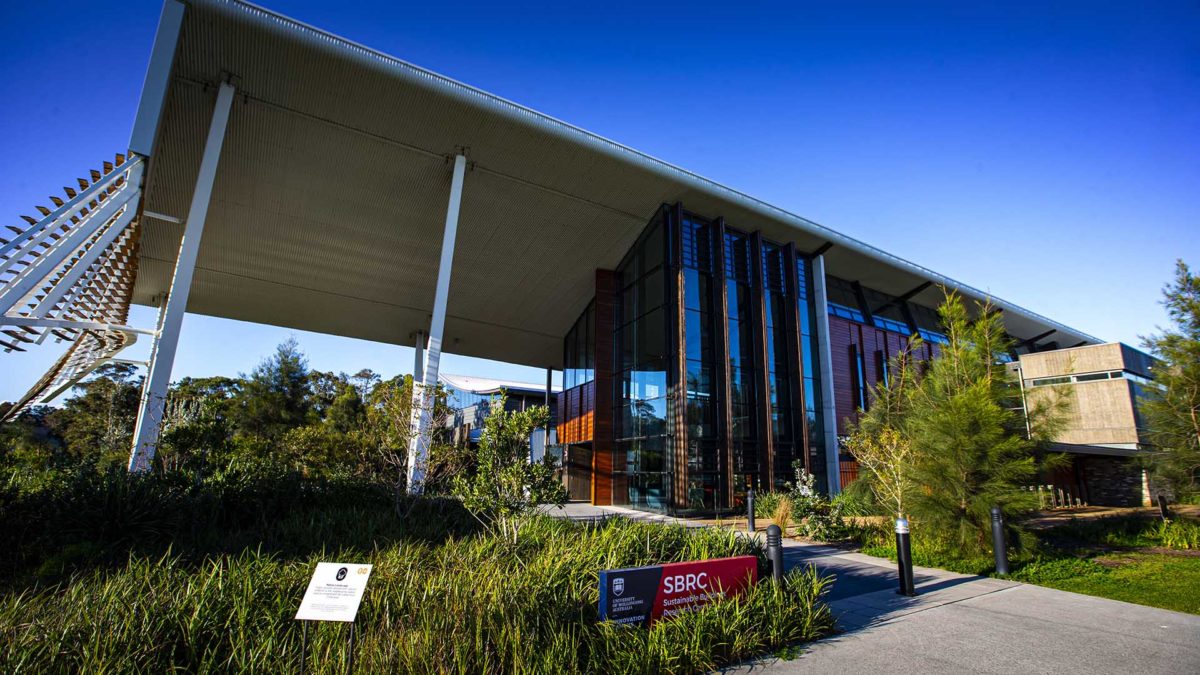The University of Wollongong’s Sustainable Buildings Research Centre (SBRC) has achieved full marks under the Living Building Challenge (LBC), setting a new benchmark as arguably the most sustainable building in Australia. To earn the full seven Petals in “the world’s most rigorous proven performance standard for buildings”, the SBRC building was tested against stringent performance standards and metrics covering energy use, site utilisation, health and happiness, equity, beauty, water and materials used.
The SBRC has joined an exclusive list of only 23 other buildings in the world that have met all seven Petals and are considered Living Certified. It has become the first project in Australia to achieve any level of LBC certification, and only the third Living Certified project outside of the United States. “The certification process has been a long and difficult journey since the building was completed in 2013,” SBRC Director Senior Professor Paul Cooper said. “This process has involved the extensive monitoring of all aspects of building performance, and sourcing difficult-to-access as-built documentation for every component that went into the construction of the building.”
Leading by example
The research centre integrates a wide range of green features, that range from a 160 kWp solar PV array and microgrid, through ground source heat pumps, to a $1.8 million ‘Building Insights Facility’ for thermal testing of building facades and air conditioning systems. It was built based on the LBC regenerative design framework as a way to design and construct a building that is not just sustainable but aims to be restorative.
As Professor Cooper explains, “sustainable means effectively you’re not doing any net harm overall – but restorative means you’re doing something that’s addressing some of the environmental damage that has been done in the past”. To achieve this, the SBRC team had to track every single item and material that came into the building during construction. This meant that no ‘red list’ materials, such as formaldehyde, chromium, mercury, PVC, were allowed in the building materials or pieces of equipment or building elements unless an exemption has been given.
“There were also sourcing restrictions on the building materials, for example steel and concrete could be sourced from no more than 500km away, to limit ‘embodied’ carbon emissions and environmental impact due to transport of the construction materials to site,” Cooper said. “From day one, I said to the design team that we wanted to create a building that went way beyond the current benchmark for sustainable buildings. We believe society as a whole needs to do much better than that.”
The SBRC is not only an environmentally friendly building but also a living laboratory where scientists are testing and developing new approaches to retrofitting techniques to create more effective places to live and work. The centre is home to a research team of approximately 40 staff and students and a multi-disciplinary facility that hosts a wide range of research and industry collaborations to address the challenges of making buildings sustainable.
The aim of the SBRC is to research, collaborate, and link with industry to meet the challenge of improving the energy efficiency of our new and existing building stock. Situated at the Innovation Campus, the centre’s Exhibition Foyer is open to the public during work hours. “It is hoped people will explore the building and gardens, and be inspired to design their homes using similar principles,” Professor Cooper said.
More buildings going up, as are their emissions
Buildings in Australia account for over 50% of electricity use and almost a quarter of the country’s carbon emissions. In a recent article for The Conversation, Timoty O’Leary, lecturer in construction and property at the University of Melbourne, reminds that buildings – whether residential, commercial or institutional – do not score well under the nation’s main emissions reduction program, the $3.5 billion Climate Solutions Package, which is intended to help Australia meet its commitments under the Paris Agreement.
Noting that most energy-efficiency studies and programs focus solely on the operational aspect of buildings, such as the energy used to heat and cool them, O’Leary says that various studies have proved that the energy and emissions required to manufacture building products, even energy-saving products such as insulation, can be just as significant. “A more holistic approach is to look at the embodied energy already in our building stock, which then poses a serious question about our consumption. So, besides aspirational codes for net zero-energy buildings, we should be asking: can we meet our needs with fewer new buildings?” he writes.
This content is protected by copyright and may not be reused. If you want to cooperate with us and would like to reuse some of our content, please contact: editors@pv-magazine.com.









The insulation called “pink bats” are not the most efficient insulating material available. The “spray in” foam or the factory manufactured urethane insulation product sandwiched between two sheets of OSB and used for a structural “skin” , SIPs (Structural Insulated Panels) for building walls, roofs with R50 values and often walls with R35 values. The down side, urethane an oil derived product, when it burns, it is very toxic. Would there then be a urethane product that is (less) toxic that could be used? Up side, it will last decades, keep moisture out of the wall voids and provide a tight and well insulated shell for the home. Reduce energy use greatly, but require an effective HVAC air exchange 24/7 to keep the house’s indoor air quality healthy.